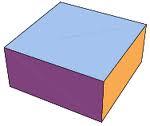Rectangular cuboid
The rectangular cuboid has a surface area 4131 cm2, and its dimensions are in the ratio 2:4:5. Find the volume of this rectangular cuboid.
Final Answer:

Tips for related online calculators
Are you looking for help with calculating roots of a quadratic equation?
Check out our ratio calculator.
Do you have a linear equation or system of equations and are looking for its solution? Or do you have a quadratic equation?
Tip: Our volume units converter will help you convert volume units.
Check out our ratio calculator.
Do you have a linear equation or system of equations and are looking for its solution? Or do you have a quadratic equation?
Tip: Our volume units converter will help you convert volume units.
You need to know the following knowledge to solve this word math problem:
algebraarithmeticsolid geometryplanimetricsbasic operations and conceptsnumbersUnits of physical quantitiesGrade of the word problem
We encourage you to watch this tutorial video on this math problem: video1
Related math problems and questions:
- Cuboid - edges
 The cuboid has dimensions in a ratio of 4:3:5. The shortest edge is 12 cm long. Find: The lengths of the remaining edges The surface of the cuboid The volume of the cuboid
The cuboid has dimensions in a ratio of 4:3:5. The shortest edge is 12 cm long. Find: The lengths of the remaining edges The surface of the cuboid The volume of the cuboid - Dimensions 20553
 The surface of the block is 558 cm², and its dimensions are in the ratio of 5:3:2. Calculate the volume.
The surface of the block is 558 cm², and its dimensions are in the ratio of 5:3:2. Calculate the volume. - Rectangular 7647
 There are 140 liters of water in a rectangular aquarium with 800 mm and 50 cm base dimensions. How high in cm does the water level reach? What is the area in dm² of the inner walls of this aquarium up to the water level?
There are 140 liters of water in a rectangular aquarium with 800 mm and 50 cm base dimensions. How high in cm does the water level reach? What is the area in dm² of the inner walls of this aquarium up to the water level? - Cuboid to cube
 A cuboid with dimensions of 9 cm, 6 cm, and 4 cm has the same volume as a cube. Calculate the surface of this cube.
A cuboid with dimensions of 9 cm, 6 cm, and 4 cm has the same volume as a cube. Calculate the surface of this cube. - Cuboid - ratio
 Find the volume of a block whose dimensions are in the ratio 2:3:4 and the surface is 117 dm².
Find the volume of a block whose dimensions are in the ratio 2:3:4 and the surface is 117 dm². - Cuboid - ratios
 The sizes of the edges of the cuboid are in the ratio of 2:3:5. The smallest wall has an area of 54 cm². Calculate the surface area and volume of this cuboid.
The sizes of the edges of the cuboid are in the ratio of 2:3:5. The smallest wall has an area of 54 cm². Calculate the surface area and volume of this cuboid. - Two rectangular boxes
 Two rectangular boxes with dimensions of 5 cm, 8 cm, 10 cm, and second of 5 cm, 12 cm, and 1 dm will be replaced by a single cube box of the same cubic volume. Calculate its surface.
Two rectangular boxes with dimensions of 5 cm, 8 cm, 10 cm, and second of 5 cm, 12 cm, and 1 dm will be replaced by a single cube box of the same cubic volume. Calculate its surface.
